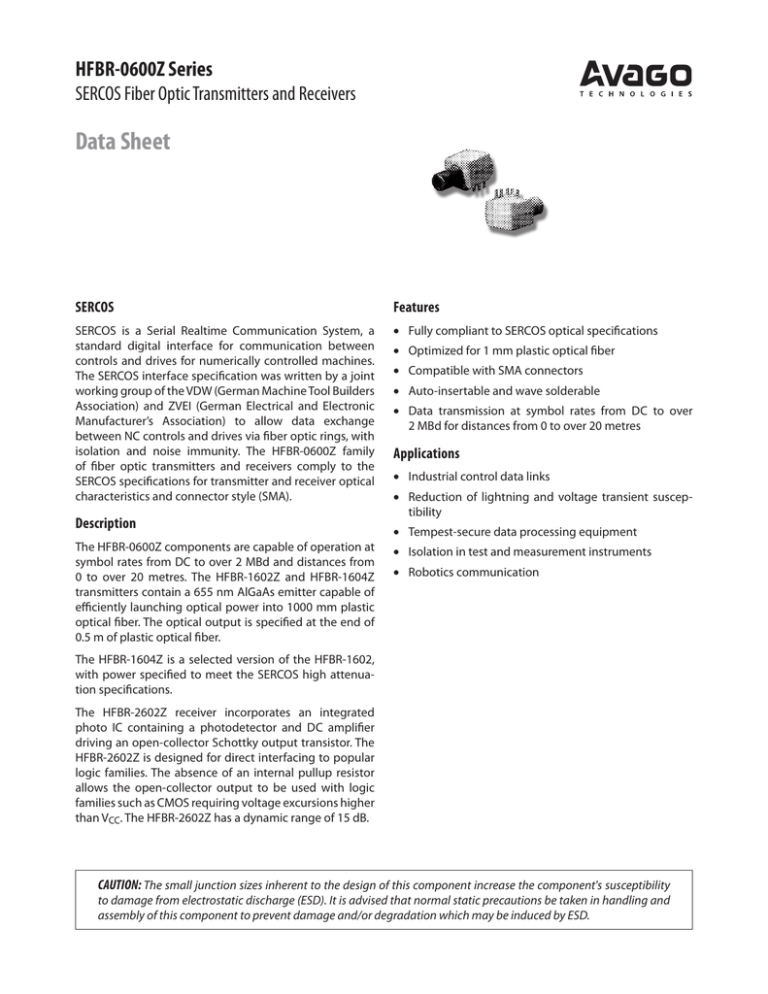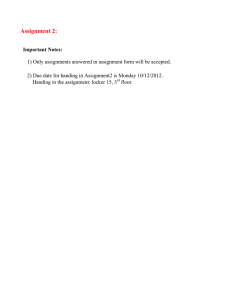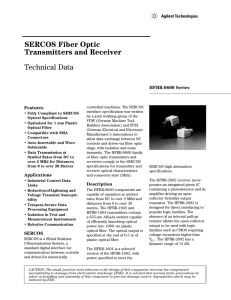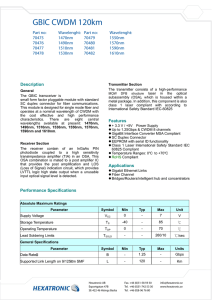
HFBR-0600Z Series
SERCOS Fiber Optic Transmitters and Receivers
Data Sheet
SERCOS
Features
SERCOS is a Serial Realtime Communication System, a
standard digital interface for communication between
controls and drives for numerically controlled machines.
The SERCOS interface specification was written by a joint
working group of the VDW (German Machine Tool Builders
Association) and ZVEI (German Electrical and Electronic
Manufacturer’s Association) to allow data exchange
between NC controls and drives via fiber optic rings, with
isolation and noise immunity. The HFBR-0600Z family
of fiber optic transmitters and receivers comply to the
SERCOS specifications for transmitter and receiver optical
characteristics and connector style (SMA).
Fully compliant to SERCOS optical specifications
Description
Tempest-secure data processing equipment
The HFBR-0600Z components are capable of operation at
symbol rates from DC to over 2 MBd and distances from
0 to over 20 metres. The HFBR-1602Z and HFBR-1604Z
transmitters contain a 655 nm AlGaAs emitter capable of
efficiently launching optical power into 1000 mm plastic
optical fiber. The optical output is specified at the end of
0.5 m of plastic optical fiber.
Optimized for 1 mm plastic optical fiber
Compatible with SMA connectors
Auto-insertable and wave solderable
Data transmission at symbol rates from DC to over
2 MBd for distances from 0 to over 20 metres
Applications
Industrial control data links
Reduction of lightning and voltage transient susceptibility
Isolation in test and measurement instruments
Robotics communication
The HFBR-1604Z is a selected version of the HFBR-1602,
with power specified to meet the SERCOS high attenuation specifications.
The HFBR-2602Z receiver incorporates an integrated
photo IC containing a photodetector and DC amplifier
driving an open-collector Schottky output transistor. The
HFBR-2602Z is designed for direct interfacing to popular
logic families. The absence of an internal pullup resistor
allows the open-collector output to be used with logic
families such as CMOS requiring voltage excursions higher
than VCC. The HFBR-2602Z has a dynamic range of 15 dB.
CAUTION: The small junction sizes inherent to the design of this component increase the component's susceptibility
to damage from electrostatic discharge (ESD). It is advised that normal static precautions be taken in handling and
assembly of this component to prevent damage and/or degradation which may be induced by ESD.
HFBR-160XZ Transmitters
HFBR-0600Z SMA Series
Mechanical Dimensions
Pin
Function
1*
2
3
4*
5*
6
7**
8*
N.C.
ANODE
N.C.
N.C.
N.C.
N.C.
CATHODE
N.C.
Pin
Function
1*
2
3
4*
5*
6
7
8*
N.C.
VCC (5 V)
COMMON
N.C.
N.C.
DATA
COMMON
N.C.
HFBR-2602Z Receiver
*
Pins 1, 4, 5, and 8 are isolated from the internal circuitry, but
electrically connected to one another.
** Transmitter Pin 7 may be left unconnected if necessary.
In the receiver, both the opencollector “Data” output Pin 6
and VCC Pin 2 are referenced to “Common” Pin 3 and 7.
It is essential that a bypass capacitor (0.1 F ceramic) be
connected from Pin 2 (VCC) to Pin 3 (circuit common) of
the receiver.
2
SMA is an industry standard fiber optic connector,
available from many fiber optic connector suppliers.
HFBR-4401Z is a kit consisting of 100 nuts and 100 washers
for panel mounting the HFBR-0600Z components.
HFBR-1602Z/1604Z Transmitters
Absolute Maximum Ratings
Parameter
Symbol
Min.
Max.
Units
Storage Temperature
TS
-55
85
°C
Operating Temperature
TA
-40
85
°C
Temp.
260
°C
Note 1
Time
10
s
Note 1
IFPK
120
mA
Forward Input Current Average
IFavg
60
mA
Reverse Input Voltage
VBR
-5
V
Lead Soldering Cycle
Forward Input Current Peak
Reference
Electrical/Optical Characteristics 0 to 55° C, unless otherwise stated.
Parameter
Symbol
Min.
Typ.[2]
Max.
Unit
Condition
Forward Voltage
VF
1.5
1.9
2.2
V
IF = 35 mA
Forward Voltage
Temp. Coefficient
VF/T
-1.2
mV/°C
IF = 35 mA
Reverse Input Voltage
VBR
-5.0
-18
V
IR = 100 A
Peak Emission Wavelength
P
640
655
675
Full Width Half Maximum
FWHM
20
30
nm
25° C
Diode Capacitance
CT
30
pF
VF = 0
f = 1 MHz
Optical Power
Temp. Coefficient
PT/T
-0.01
dBm/°C
IF = 35 mA
Thermal Resistance
JA
330
°C/W
Peak Optical Output
Power of HFBR-1602Z
PT1602
-10.5
-5.5
dBm
IF = 35 mA
Notes 5, 6,11
Peak Optical Output
Power of HFBR-1604Z
PT1604
-7.5
-10.5
-3.5
-5.5
dBm
dBm
IF = 60 mA
IF = 35 mA
Notes 5, 6,11
Rise Time (10% to 90%)
tr
57
50
ns
ns
IF = 60 mA
IF = 35 mA
Fall Time (90% to 10%)
tf
40
27
ns
ns
IF = 60 mA
IF = 35 mA
3
Reference
nm
Notes 3, 4
HFBR-2602Z Receiver
Absolute Maximum Ratings
Parameter
Symbol
Min.
Max.
Units
Storage Temperature
TS
-55
85
°C
Operating Temperature
TA
-40
85
°C
Temp.
260
°C
Note 1
Time
10
s
Note 1
7.0
V
25
mA
18.0
V
mW
Lead Soldering Cycle
Supply Voltage
-0.5
Vcc
Output Current
IO
Output Voltage
VO
Output Collector Power Dissipation
PO AVG
40
Fan Out (TTL)
N
5
-0.5
Reference
Note 8
Electrical/Optical Characteristics 0 to 55° C;
Fiber core diameter ≤ 1.0 mm, fiber N.A. ≤ 0.5, 4.75 V ≤ VCC ≤ 5.25 V
Typ.[2]
Max.
Unit
Condition
IOH
5
250
A
VOH = 18 V
PR < -31.2 dBm
Low Level Output Voltage
VOL
0.4
0.5
V
IOL = 8 mA
PR > -20.0 dBm
High Level Supply Current
ICCH
3.5
6.3
mA
VCC = 5.25 V
PR < -31.2 dBm
Low Level Supply Current
ICCL
6.2
10
mA
VCC = 5.25 V
PR > -20.0 dBm
Parameter
Symbol
High Level Output Current
Min.
Reference
Dynamic Characteristics 0 to 55° C unless otherwise specified; 4.75 V ≤ VCC ≤ 5.25 V; BER ≤ 10-9
Parameter
Symbol
Peak Input Power
Level Logic HIGH
PRH
Peak Input Power
Level Logic LOW
PRL
Propagation Delay
LOW to HIGH
tPLH
Propagation Delay
HIGH to LOW
Pulse Width Distortion,
tPLH - tPHL
Min.
Typ.[2]
Max.
Unit
Condition
Reference
-31.2
dBm
P = 655 nm
Note 7
-5.0
dBm
IOL = 8 mA
Note 7
60
ns
PR = -20 dBm
2 MBd
Note 8, 9
tPHL
110
ns
PR = -20 dBm
2 MBd
Note 8, 9
PWD
50
-50
ns
ns
PR = -5 dBm
PR = -20 dBm
Note 10
Figure 6
-20.0
Notes:
1. 2.0 mm from where leads enter case.
2. Typical data at TA = +25° C.
3. Thermal resistance is measured with the transmitter coupled to a connector assembly and fiber, and mounted on a printed circuit board.
4. Pins 2, 6, and 7 are welded to the cathode header connection to minimize the thermal resistance from junction to ambient. To further reduce the
thermal resistance, the cathode trace should be made as large as is consistent with good RF circuit design.
5. PT is measured with a large area detector at the end of 0.5 metre of plastic optical fiber with 1 mm diameter and numerical aperture of 0.5.
6. When changing W to dBm, the optical power is referenced to 1 mW (1000 W). Optical Power P(dBm) = 10 log [P (W)/1000 W].
7. Measured at the end of 1mm plastic fiber optic cable with a large area detector.
8. 8 mA load (5 x 1.6 mA), RL = 560 .
9. Propagation delay through the system is the result of several sequentially occurring phenomena. Consequently it is a combination of data-ratelimiting effects and of transmission-time effects. Because of this, the data-rate limit of the system must be described in terms of time differentials
between delays imposed on falling and rising edges. As the cable length is increased, the propagation delays increase. Data-rate, as limited by
pulse width distortion, is not affected by increasing cable length if the optical power level at the receiver is maintained.
10. Pulse width distortion is the difference between the delay of the rising and falling edges.
11. Both HFBR-1602Z and HFBR-1604Z meet the SERCOS "low attenuation" specifications when operated at 35 mA; only HFBR-1604Z meets the
SERCOS "high attenuation" limits when operated at 60 mA.
4
Figure 1. Forward voltage and current characteristics.
Figure 2. Typical transmitter output vs. forward current.
Figure 3. Transmitter spectrum normalized to the peak at 25° C.
Figure 4. Typical propagation delay through system with 0.5 metre of cable.
Figure 5. Typical HFBR-160XZ/2602Z link pulsewidth distortion vs. optical
power.
5
Figure 6. System propagation delay test circuit and waveform timing definitions.
For product information and a complete list of distributors, please go to our web site:
www.avagotech.com
Avago, Avago Technologies, and the A logo are trademarks of Avago Technologies in the United States and other countries.
Data subject to change. Copyright © 2005-2012 Avago Technologies. All rights reserved. Obsoletes 5989-4798EN
AV02-3638EN - June 19, 2012








